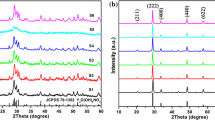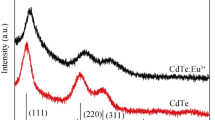Abstract
For the first time, a hierarchical phosphor Y2O3:Eu3+/MCM-41/YVO4:Eu3+, with a core–shell-core heterostructure, is presented in this study. Synergistically bridging the phosphors Y2O3:Eu3+ (as an inner core) and YVO4:Eu3+ (as an outer core) by amorphous SiO2, i.e., MCM-41 (with ordered mesoporous channels) leads to the generation of the core–shell-core heterostructure with enhanced red emission and tunable, broadened-band response to excitation. The novel structure of the core–shell-core hierarchical material is clarified through various characterization methods including X-ray diffraction analysis, transmission electron microscopy, selected-area electron diffraction and N2 adsorption–desorption measurements. Significantly, through temperature-dependent fluorescence investigation, it is found that our core–shell phosphor (Y2O3:Eu3+/MCM-41) exhibits impressive fluorescence stability against temperature variation (27–227 °C) due to the protective effect resulting from MCM-41. By contrast, lowered stability can be noted for the core–shell-core phosphor (Y2O3:Eu3+/MCM-41/YVO4:Eu3+), especially when the temperature is higher than 100 °C, owing to the outer core (YVO4:Eu3+ nanoparticles) that is directly exposed to heat. Such a kind of luminescent materials holds substantial promise for labeling the organisms that are vulnerable to short-wavelength UV light irradiation. Additionally, potential intelligent systems can be expected to be designed on the basis of the fluorescence mutation as triggered by the temperature of 100 °C.










Similar content being viewed by others
References
H. Hu, J.H. Xin, H. Hu, X. Wang, D. Miao, Y. Liu, Synthesis and stabilization of metal nanocatalysts for reduction reactions: a review. J. Mater. Chem. A 3, 11157 (2015). doi:10.1039/c5ta00753d
H. Yu, Q. Dong, Z. Jiao et al., Ion exchange synthesis of PAN/Ag3PO4core–shell nanofibers with enhanced photocatalytic properties. J. Mater. Chem. A 2, 1668 (2014). doi:10.1039/c3ta14447j
J. Treu, M. Bormann, H. Schmeiduch et al., Enhanced luminescence properties of InAs–InAsP core–shell nanowires. Nano Lett. 13, 6070 (2013). doi:10.1021/nl403341x
G.Z. Jia, W.K. Lou, F. Cheng et al., Excellent photothermal conversion of core/shell CdSe/Bi2Se3 quantum dots. Nano Res. 8, 1443 (2015). doi:10.1007/s12274-014-0629-2
Y. Zhao, Y. Zhang, H. Zhao et al., Epitaxial growth of hyperbranched Cu/Cu2O/CuO core-shell nanowire heterostructures for lithium-ion batteries. Nano Res. 8, 2763 (2015). doi:10.1007/s12274-015-0783-1
N. Zhang, B. Zhu, F. Peng et al., Synthesis of metal–organic-framework related core–shell heterostructures and their application to ion enrichment in aqueous conditions. Chem. Commun. 50, 7686 (2014). doi:10.1039/c4cc00900b
X. Xia, J. Tu, Y. Zhang et al., High-quality metal oxide core/shell nanowire arrays on conductive substrates for electrochemical energy storage. ACS Nano 6, 5531 (2012). doi:10.1021/nn301454q
J. Wang, H. Huang, D. Zhang et al., Synthesis of gold/rare-earth-vanadate core/shell nanorods for integrating plasmon resonance and fluorescence. Nano Res. 8, 2548 (2015). doi:10.1007/s12274-015-0761-7
H. Hu, J.H. Xin, H. Hu, X. Wang, Y. Kong, Metal-free graphene-based catalyst—Insight into the catalytic activity: a short review. Appl. Catal. A 492, 1 (2015). doi:10.1016/j.apcata.2014.11.041
Y. Guo, L. Zhang, X. Liu et al., Synthesis of magnetic core–shell carbon dot@MFe2O4(M = Mn, Zn and Cu) hybrid materials and their catalytic properties. J. Mater. Chem. A 4, 4044 (2016). doi:10.1039/c5ta10708c
Y. Zhang, Y. Guo, Q. Du et al., Oxygen vacancies induced self-assembling synthesis of V4+-BiVO4/rGO core-shell nanorods with enhanced water splitting efficiency and superior sewage purification capability. Appl. Catal. A 526, 105 (2016). doi:10.1016/j.apcata.2016.08.012
X. Chen, D. Peng, Q. Ju, F. Wang, Photon upconversion in core–shell nanoparticles. Chem. Soc. Rev. 44, 1318 (2015). doi:10.1039/c4cs00151f
H. Hu, J. Xin, H. Hu, X. Wang, X. Lu, Organic liquids-responsive β-cyclodextrin-functionalized graphene-based fluorescence probe: label-free selective detection of tetrahydrofuran. Molecules 19, 7459 (2014). doi:10.3390/molecules19067459
H. Hu, M. Chang, M. Zhang, X. Wang, D. Chen, A new insight into PAM/graphene-based adsorption of water-soluble aromatic pollutants. J. Mater. Sci. 52, 8650 (2017). doi:10.1007/s10853-017-1090-x
I.P. Sahu, D.P. Bisen, N. Brahme, R.K. Tamrakar, Studies on the luminescence behavior of SrCaMgSi2O7:Eu3+ phosphor by solid state reaction method. J. Mater. Sci. 27, 1828 (2015). doi:10.1007/s10854-015-3961-8
R. Cao, T. Fu, Y. Cao, et al., Tunable emission, energy transfer, and charge compensation in the CaSb2O6:Eu3+, Bi3+ phosphor. J. Mater. Sci. 27, 3514 (2015). doi:10.1007/s10854-015-4186-6
H. Zhang, Z. Cheng, Y. Zhang, Z. Hu, J. Yu, N. Zou, Improved luminescence properties and thermal stability of SrSi2O2N2:Eu2+ phosphor with single phase via the formation of Eu3+ on surface structure. J. Mater. Sci 52, 7605 (2017). doi:10.1007/s10853-017-0992-y
W. You, Z. Xiao, F. Lai et al., Synthesis and photoluminescence properties of Ba3Al2O6:Eu3+ red phosphor. J. Mater. Sci 51, 5403 (2016). doi:10.1007/s10853-016-9843-5
H. He, R. Fu, F. Qian, X. Song, Luminescent properties of Li2CaSiO4:Eu2+ phosphor. J. Mater. Sci. 23, 599 (2011). doi:10.1007/s10854-011-0447-1
A. John Peter, I.B. Shameem Banu, J. Thirumalai, S.P. David, Enhanced luminescence in CaMoO4: Eu3+ red phosphor nanoparticles prepared by mechanochemically assisted solid state meta-thesis reaction method. J. Mater. Sci. 24, 4503 (2013). doi:10.1007/s10854-013-1433-6
M. Elsagh, M. Rajabi, E. Amini Characterization of SrAl2O4:Eu2+, Dy3+ phosphor nano-powders produced by microwave synthesis route. J. Mater. Sci. 25, 1612 (2014). doi:10.1007/s10854-014-1773-x
I.P. Sahu, The role of europium and dysprosium in the bluish-green long lasting Sr2Al2SiO7:Eu2+, Dy3+ phosphor by solid state reaction method. J. Mater. Sci. 26, 7059 (2015). doi:10.1007/s10854-015-3327-2
Y. Zhang, H. Hu, M. Chang, et al., Non-uniform doping outperforms uniform doping for enhancing the photocatalytic efficiency of Au-doped TiO2 nanotubes in organic dye degradation. Ceram. Int. 43, 9053 (2017). doi:10.1016/j.ceramint.2017.04.050
H. Hu, J.H. Xin, H. Hu, PAM/graphene/Ag ternary hydrogel: synthesis, characterization and catalytic application. J. Mater. Chem. A 2, 11319 (2014). doi:10.1039/c4ta01620c
L. Graziani, E. Quagliarini, M. D’Orazio, TiO2-treated different fired brick surfaces for biofouling prevention: Experimental and modelling results. Ceram. Int. 42, 4002 (2016). doi:10.1016/j.ceramint.2015.11.069
A. Shirai, T. Watanabe, H. Matsuki, Inactivation of foodborne pathogenic and spoilage micro-organisms using ultraviolet-a light in combination with ferulic acid. Lett. Appl. Microbiol. 64, 96 (2017). doi:10.1111/lam.12701
Y. Liang, K. Sun, P. Chui, S. Wang, X. Sun, Luminescence functionalization of magnetite/multiwalled carbon nanotubes by YVO4:Eu3+ phosphors. Solid State Sci. 15, 79. doi:10.1016/j.solidstatesciences.2012.09.009
Y.N. Zhu, W.W. Fu, PF Zhang, GH Zheng, JJ Mu, LY Zhang (2016) Self-assembled 3D micro-architectures of Sr3V2O8:xSm3+ ‘hydrothermal’ synthesis and luminescent properties. J. Mater. Sci. 27, 12772. doi:10.1007/s10854-016-5409-1
Q. Zhang, M. Rong, H. Tan, et al., Luminescent properties of the white long afterglow phosphors: Sr3Al2O5Cl2: Eu2+, Dy3+. J. Mater. Sci. 27, 13093 (2016). doi:10.1007/s10854-016-5453-x
L.-q. Yao, G.-h. Chen, T. Yang, C.-l. Yuan, C.-r. Zhou, Energy transfer, optical and luminescent properties in Tm3+/Tb3+/Sm3+ tri-doped borate glasses. J. Mater. Sci. 28, 553 (2016). doi:10.1007/s10854-016-5558-2
C. Yang, H. Zhou, J. Xu, et al. (2016) A series of highly quantum efficiency PMMA luminescent films doped with Eu-complex as promising light-conversion molecular devices. J. Mater. Sci. 27, 11284. doi:10.1007/s10854-016-5251-5
Y. Xing, Y. Zhu, C. Chang, Y. Wang, Y. Wang, New synthetic method and the luminescent properties of green-emitting β-Sialon: Eu2+ phosphors. J. Mater. Sci. (2017). doi:10.1007/s10854-017-6689-9
D. Thapa, J. Huso, K. Miklos, et al., UV-luminescent MgZnO semiconductor alloys: nanostructure and optical properties. J. Mater. Sci. 28, 2511 (2016). doi:10.1007/s10854-016-5825-2
M.M. Haque, H.-I. Lee, K.N. Hui, Investigation of luminescent properties of red-emitting Ba(Gd,Eu)B9O16 phosphors and the effect of Ca and Sr on its luminescent properties. J. Mater. Sci. 26, 4754 (2015). doi:10.1007/s10854-015-3161-6
J.M. Carvalho, L.C.V. Rodrigues, M.C.F.C. Felinto, L.A.O. Nunes, J. Hölsä, H.F. Brito, Structure–property relationship of luminescent zirconia nanomaterials obtained by sol–gel method. J. Mater. Sci 50, 873 (2014). doi:10.1007/s10853-014-8648-7
J. Cao, H. Niu, Z. Lu, P. Huo, Y. Yan, Green synthesis of highly luminescent ZnS:Mn2+ quantum dots. J. Mater. Sci. 27, 6175 (2016). doi:10.1007/s10854-016-4545-y
H. Hu, C.C.K. Allan, J. Li et al., Multifunctional organically modified graphene with super-hydrophobicity. Nano Res. 7, 418 (2014). doi:10.1007/s12274-014-0408-0
H.-W. Hu, J.H. Xin, H. Hu (2013) Highly efficient graphene-based ternary composite catalyst with polydopamine layer and copper nanoparticles. ChemPlusChem 78, 1483. doi:10.1002/cplu.201300124
H. Hu, M. Chang, X. Wang, D. Chen, Cotton fabric-based facile solar photocatalytic purification of simulated real dye wastes. J. Mater. Sci. 52, 9922 (2017). doi:10.1007/s10853-017-1107-5
E. Dündar-Tekkaya, Y. Yürüm, Mesoporous MCM-41 material for hydrogen storage: a short review. Int. J. Hydrog. Energy 41, 9789 (2016). doi:10.1016/j.ijhydene.2016.03.050
S. Loganathan, M. Tikmani, A.K. Ghoshal, Novel pore-expanded MCM-41 for CO2 capture: synthesis and characterization. Langmuir 29, 3491 (2013). doi:10.1021/la400109j
M Mandal, V Nagaraju, B Sarma, GV Karunakar, KK Bania (2015) Enantioselective epoxidation of styrene by manganese chiral schiff base complexes immobilized on MCM-41. ChemPlusChem 80, 749. doi:10.1002/cplu.201402446
D.J. Jovanović, Ž. Antić, R.M. Krsmanović et al., Annealing effects on the microstructure and photoluminescence of Eu3+-doped GdVO4 powders. Opt. Mater. 35, 1797 (2013). doi:10.1016/j.optmat.2013.03.012
Y. Jia, W. Lü, N. Guo, W. Lü, Q. Zhao, H. You, Utilizing Tb3+ as an energy transfer bridge to connect Eu2+–Sm3+ luminescent centers: realization of efficient Sm3+ red emission under near-UV excitation. Chem. Commun. 49, 2664 (2013). doi:10.1039/c3cc39277e
X. He, Y. Zhou, H. Liang, Cun+-assisted synthesis of multi- and single-hase yttrium oxide nanosheets. J. Mater. Chem. C 1, 6829 (2013). doi:10.1039/c3tc31321b
Y. Chi, Q. Yuan, Y. Li, et al., Magnetically separable Fe3O4@SiO2@TiO2–Ag microspheres with well-designed nanostructure and enhanced photocatalytic activity. J. Hazard. Mater. 262, 404 (2013). doi:10.1016/j.jhazmat.2013.08.077
H. Hu, J.H. Xin, H. Hu, A. Chan, L. He, Glutaraldehyde–chitosan and poly (vinyl alcohol) blends, and fluorescence of their nano-silica composite films. Carbohydr. Polym. 91, 305 (2013). doi:10.1016/j.carbpol.2012.08.038
D. Wawrzynczyk, M. Nyk, M. Samoc, Multiphoton absorption in europium(iii) doped YVO4 nanoparticles. J. Mater. Chem. C 1, 5837 (2013). doi:10.1039/c3tc31308e
Z. Jian, S. Huang, Y. Cao, Y. Zhang, Hydrothermal preparation and characterization of TiO2/BiVO4 composite catalyst and its photolysis of water to produce hydrogen. Photochem. Photobiol. 92, 363 (2016). doi:10.1111/php.12575
P. Yang, Z. Quan, L. Lu, S. Huang, J. Lin, H. Fu, MCM-41 functionalized with YVO4:Eu3+: a novel drug delivery system. Nanotechnology 18, 235703 (2007). doi:10.1088/0957-4484/18/23/235703
X. Xu, J. Wu, W. Xu et al., High-efficiency non-thermal plasma-catalysis of cobalt incorporated mesoporous MCM-41 for toluene removal. Catal. Today (2016). doi:10.1016/j.cattod.2016.03.036
V.Y. Gusev, X. Feng, Z. Bu, G.L. Haller, J.A. O’Brien, Mechanical stability of pure silica mesoporous MCM-41 by nitrogen adsorption and small-angle X-ray diffraction measurements. J. Phys. Chem. 100, 1985 (1996)
Y.-C. Chen, S.-C. Huang, Y.-K. Wang, Y.-T. Liu, T.-K. Wu, T.-M. Chen, Ligand-functionalization of BPEI-coated YVO4:Bi3+,Eu3+ nanophosphors for tumor-cell-targeted imaging applications. Chem. Asian J. 8, 2652 (2013). doi:10.1002/asia.201300570
J. Wang, M. Hojamberdiev, Y. Xu (2012) CTAB-assisted hydrothermal synthesis of YVO4:Eu3+ powders in a wide pH range. Solid State Sci. 14, 191. doi:10.1016/j.solidstatesciences.2011.10.019
Y. Du, Z. Hua, W. Huang et al., Mesostructured amorphous manganese oxides: facile synthesis and highly durable elimination of low-concentration NO at room temperature in air. Chem. Commun. 51, 5887 (2015). doi:10.1039/c5cc00269a
H. Hu, X. Wang, D. Miao et al., A pH-mediated enhancement of the graphene carbocatalyst activity for the reduction of 4-nitrophenol. Chem. Commun. 51, 16699 (2015). doi:10.1039/c5cc05826k
Y. Jiang, J.R. Smith, G.R. Odette (2009) Formation of Y–Ti–O nanoclusters in nanostructured ferritic alloys: a first-principles study. Phys. Rev. B. doi:10.1103/PhysRevB.79.064103
G. Liu, L. Fu, Z. Gao et al., Investigation into the temperature sensing behavior of Yb3+ sensitized Er3+ doped Y2O3, YAG and LaAlO3 phosphors. RSC Adv. 5, 51820 (2015). doi:10.1039/c5ra05986k
Acknowledgements
We greatly appreciate the Construction Project from Guangdong Engineering Technique Research Center (506302679076), High-Level Talent Start-Up Research Project of Foshan University (Gg040918), Start-Up Research Project of Foshan University (gg040948), Universities of Guangdong Province (2016GCZX008), the Project Funded by Engineering Technology Center of Foshan City (2014GA000355), and the Key Platform Financing Programs from the Education Department of Guangdong Province (gg041002).
Author information
Authors and Affiliations
Corresponding authors
Rights and permissions
About this article
Cite this article
Chang, M., Hu, H., Zhang, Y. et al. Core-shell-core heterostructural engineering of Y2O3:Eu3+/MCM-41/YVO4:Eu3+ for enhanced red emission and tunable, broadened-band response to excitation. J Mater Sci: Mater Electron 28, 16026–16035 (2017). https://doi.org/10.1007/s10854-017-7502-5
Received:
Accepted:
Published:
Issue Date:
DOI: https://doi.org/10.1007/s10854-017-7502-5




